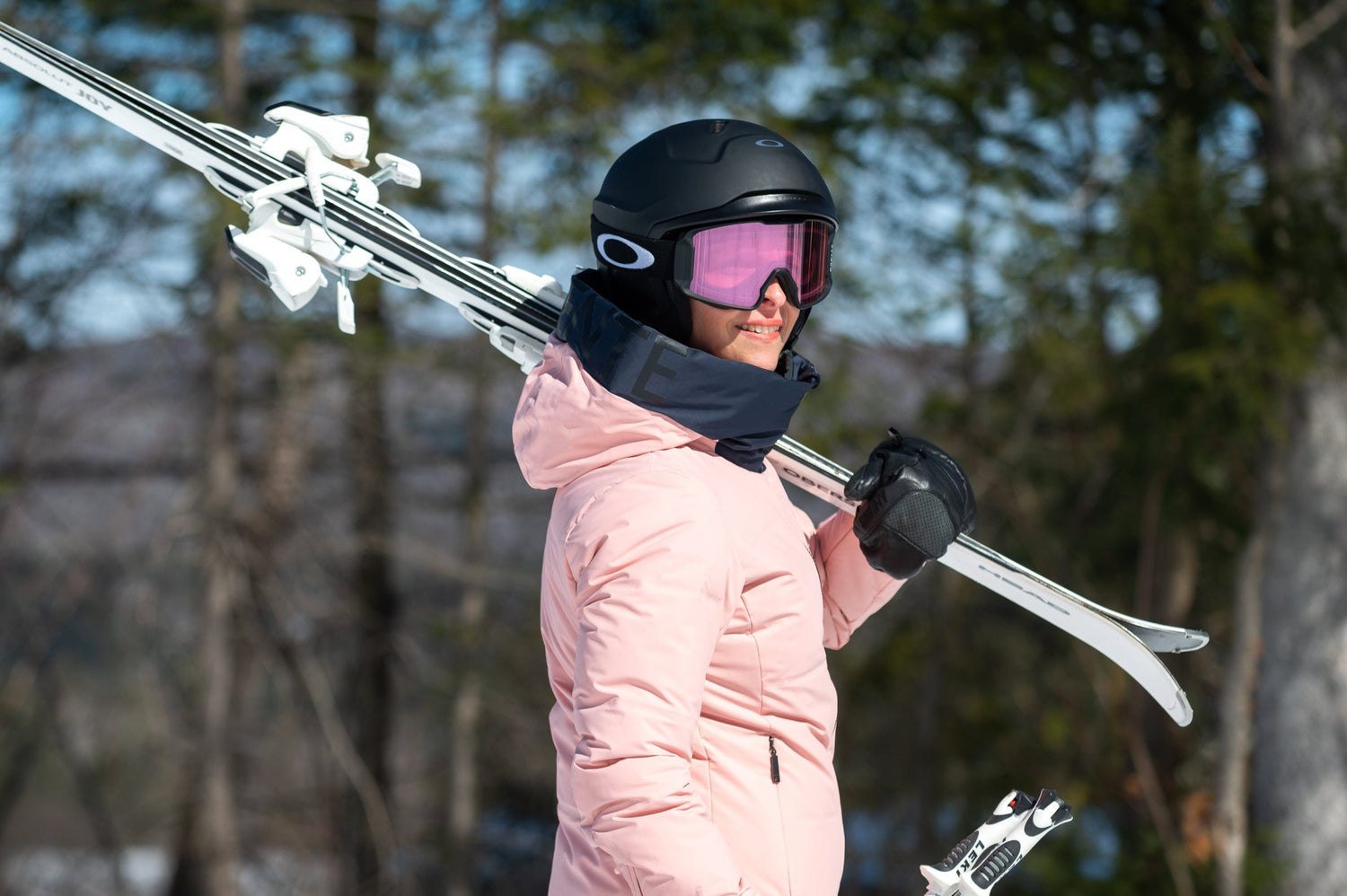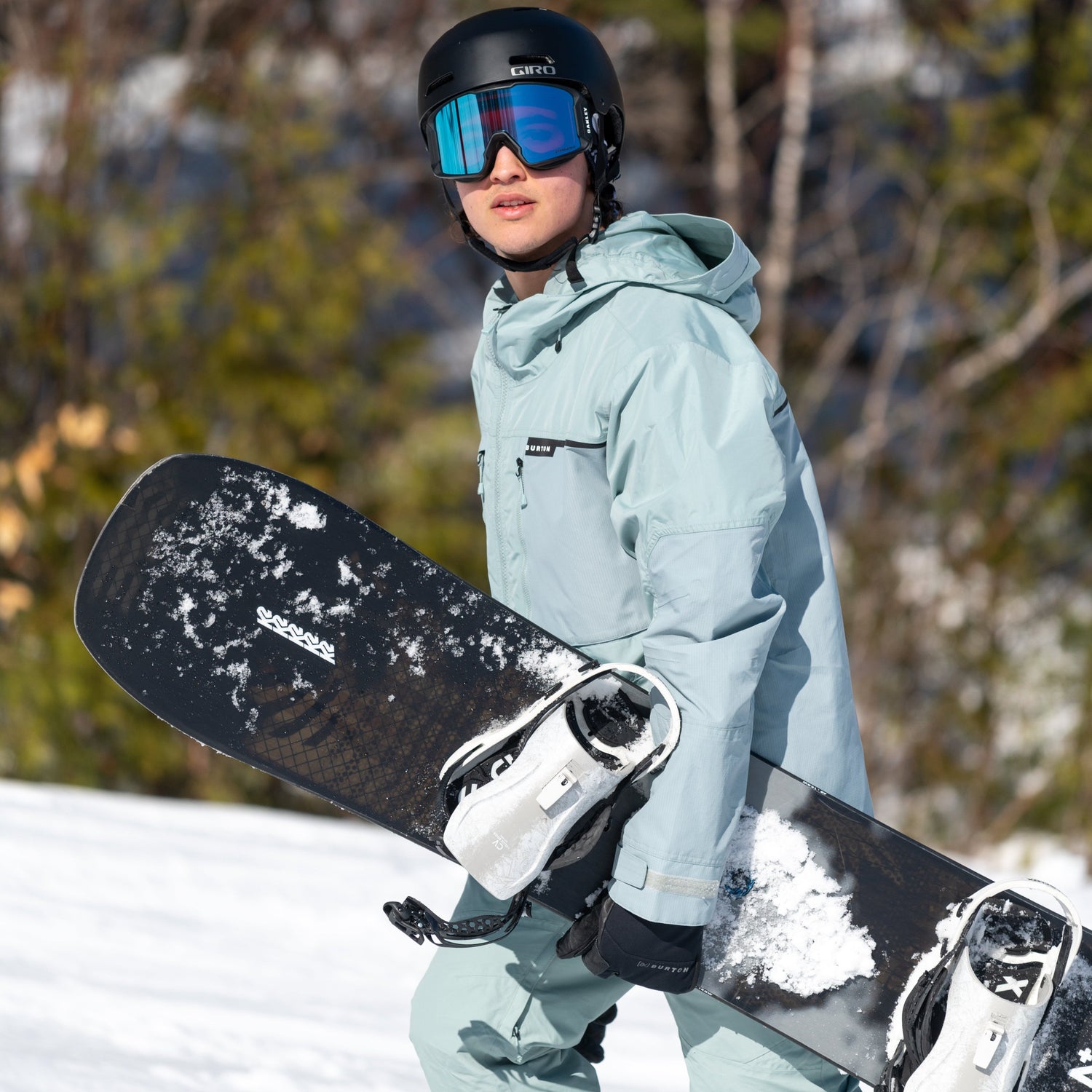An optimal experience on your boards definitely starts with choosing the right type of ski. But what characterizes each type of ski on the market? Alpine skis are divided into five main categories:
- On-piste skis
- All-mountain skis
- Freestyle skis
- Freeride skis
- Alpine touring skis
These five families are primarily defined based on their waist width in millimetres (which is measured under the binding), flex and general construction.
Each type of ski behaves differently based on the chosen terrain. That’s why you should consider your experience level on the slopes to choose a ski that meets your needs and that you’ll have fun with. Remember that a softer ski is more forgiving and easier to maneuver. It will be more suitable for beginners or recreational skiers. The more rigid the ski, the more you’ll need to be aggressive and technically sound to have full control. As with any piece of equipment, softness is also a matter of preference and comfort.

How to choose a turn radius?
Another often-discussed point needs to be demystified: turn radius. The sidecut (the width of the tip, waist and tail) determines the lateral arc left by the edge during the turn. There are skis with a short turn radius, sixteen metres for example, and models with a longer radius, more than twenty-two metres. You can feel the difference when turning. If you prefer linking up quick turns, go with a short radius and vice versa.
How to choose the right ski flex?
Soft, rigid, flex, torsion. Such words are often bandied about, but how do you choose what’s best for you? Stiffness, or ski flex, plays a critical role when you’re selecting a ski type. It determines how rigid skis are in turns—in other words, how they react during movement at low and high speeds. So the more flexible the ski, the more forgiving it is, and the stiffer it is, the more lively it is.
There are two types of ski stiffness: flex and torsional rigidity.
Ski with high torsional rigidity
- Fast edge setting at high speeds
- Better grip on hard or icy surfaces
- Turns take more effort
Ski with a stiff flex
- Better energy return
- Dynamic pop in turns
Ski with low torsional rigidity
- More forgiving of mistakes and imbalances
- Easier to maneuver at low speeds
Ski with a soft flex
- Easy to maneuver
- Facilitates turn initiation and exit
Camber and Rocker
Camber is the arch formed underfoot when the ski is laid flat without any load while the tip and tail remain on the ground. Camber gives a stronger edge hold and more pop in turns.
As for rocker profile, the tip and tail gradually rise, and the area underfoot touches the ground, still without any load. Rocker allows you to float and makes the skis easier to maneuver in powder. It also makes turning very easy, which can make turn initiation easier for beginners. However, rocker does not perform as well on hard surfaces because there are fewer points of contact. It’s harder to get a grip.
A combination of camber and rocker strikes a wonderful balance and provides significant versatility.
Women's Skis
Women’s skis are often built lighter, softer, and with a slightly forward mounting point to reflect a lower average weight and centre of gravity. However, many brands—such as Black Crows, Völkl, and Salomon—offer women’s versions identical to their unisex models except for graphics and available sizes. Others, such as Blizzard/Tecnica with its Women 2 Women program or Nordica with its Santa Ana line, continue to design constructions specifically adapted to women skiers’ real needs. Ultimately, what matters most is choosing the ski that best matches your leg strength, style, and the terrain you like to ski.

Eco-Friendly Skis
Increasingly, manufacturers, such as Atomic, Rossignol, and Elan, are using recycled materials and eco-friendly production methods. These initiatives aim to reduce the industry’s environmental impact while maintaining the same high level of performance.
Choosing Your Alpine Ski Size
If you want to choose the size of your alpine skis based on ski type, see our article How to Choose Your Ski Size.

On-Piste Skis
Do you love groomed runs from the first to the last chair? To handle this type of terrain and have fun doing so, you need a good on-piste ski. What sets it apart? It has waist width of 85 mm and under, and its construction, often with metal or carbon plates, helps the ski bite into hard surfaces.
An on-piste ski will be your best weapon to conquer the steepest groomers. In addition, with a narrower waist than other ski types, it enables quicker edging, and the stiffer tail gives you more pop when coming out of turns. Bindings are usually included with on-piste skis.
There are several construction styles for on-piste skis. They’re an outstanding choice for beginners.
Characteristics of On-Piste Skis
- 85 mm and under waist
- There are on-piste skis for both beginners and experts
- Designed for on-piste skiing and groomed surfaces
- Bindings are often included

All-Mountain Skis
Are you the kind of skier who wants to try everything on the mountain? If so, an all-mountain ski is what you need. Whether in powder, trees or on groomed surfaces, all-mountain skis are versatile thanks to waist widths between 85 mm and 90 mm. And versatility is what you’re looking for!
This type of ski can be focused a little more on a freeride than an all-mountain experience. All-mountain skis will always be tamer on-piste; they’ll never blow you away by being super dynamic coming out of turns, but they’re definitely up for anything. It’s up to you to think about what skiing experience most appeals to you.
Characteristics of All-Mountain Skis
- Waist between 85 mm and 90 mm
- Rocker at the tips
- Very versatile
- Can attack groomers and glades in different snow conditions
- May be suitable for varied skill levels depending on the ski’s construction

Freestyle Skis
If you’re a snow park enthusiast who loves features, ramps and jumps, freestyle skis are for you. The waist width, flex and camber you select will vary based on your chosen discipline.
Freestyle skis are more playful and forgiving and therefore have a less rigid construction. Their waist width ranges between 80 mm and 90 mm. The tip and tail are raised, which means they have a double rocker so you can ski switch when launching or landing. They have a more durable build because they have to handle more impacts than other types of skis.
Characteristics of Freestyle Skis
- Waist between 80 mm and 90 mm
- Impact-resistant construction
- Designed for the snow park
- Models can be focused on all-mountain freestyle
- Playful and forgiving

Freeride Skis
Do you love powder and the steeps? Freeride skis are ready for adventure! They’re wider, with a waist between 90 mm and 120 mm, and more stable and softer. This type of ski is mainly built for use in the backcountry and fresh powder. Often used as a second pair of skis in the East, freeride skis are for that perfect day when the storm of the century hits Quebec.
Choose the width based on the terrain and conditions you ski most often. If you don’t want to own a quiver of skis, it’s worth considering that freeride skis can also be used as a touring ski by pairing them with an AT binding.
Characteristics of Freeride Skis
- Waist between 90 mm and 120 mm
- Ideal for snowy conditions
- Loves steep terrain, snowy glades
- Can be used as an alpine touring ski
- For more advanced and experienced skiers

Alpine Touring Skis
Do you want to avoid the crowds? Ski in powdery wilderness? Then you should get alpine touring skis! Increasingly popular with eastern skiers, these light skis provide uphill efficiency and downhill nimbleness for exploring the mountains.
Touring skis have a waist width between 84 mm and 112 mm. Narrower models, around 84 to 95 mm underfoot, maximize lightness and uphill efficiency. They’re ideal for hardpack, ski mountaineering, and resort touring. Skis in the 95 to 105 mm range offer the versatility to handle a wide variety of snow conditions. Skis with wider waists—105 mm and above—excel in deep powder thanks to their flotation. Keep in mind, though, that the wider the ski, the heavier it tends to be. That said, some wide models remain surprisingly light thanks to carbon constructions.
When buying a touring ski, think about the types of outings you’ll mainly be going on. Since many ski areas now offer designated uphill skin trails so you can climb to the summit and then ski down on their runs, it’s sometimes unnecessary to choose a very light ski. Light skis won’t perform as well going downhill, especially in hard conditions.

Characteristics of Alpine Touring Skis
- Waist between 84 mm and 102 mm
- Lighter, so ideal for going uphill
- If the ski is very light, it won’t perform as well in tough conditions.
- Must be combined with an AT binding
- Must be used with climbing skins
- Perfect for adventurers and those who want to cover long distances
- Great for getting in shape and using the skin trail instead of the ski lift
- For intermediate to expert skiers

FAQ - Choosing the Right Alpine Skis
What type of skis should beginners choose?
Choose a piste or an all-mountain ski with a waist width between 80 and 100 mm. With narrower skis (80–90 mm) it’s easier to set an edge on hardpack. Wider models (90–100 mm) provide better stability in soft or chopped-up snow. A soft to medium flex and a twin-rocker profile make turning easier and help correct small mistakes.
What ski width should I choose?
Ski width, measured underfoot, directly affects both manoeuvrability and float. Narrow skis (70–85 mm) are quicker edge to edge and provide strong edge grip on hardpack, which is ideal for groomed runs. Mid-width models (85–95 mm) offer versatility and perform well in most conditions. Wide skis (95–105 mm and up) float better in powder but require more effort on groomed terrain. Choose according to your preferred terrain and skiing style.
Can I use my touring skis at the resort?
Yes, but with a few trade-offs. Touring skis are designed to be lightweight and efficient on the climb, which often makes them less stable and less responsive on hardpack descents. For resort skiing, a traditional alpine setup is a better choice. Keep in mind, too, that tech bindings don’t always have the same safety certification as alpine bindings, which can make resort use risky. If you plan to ski inbounds regularly with touring skis, opt instead for a hybrid binding that offers certified release safety.




